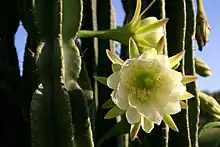Cereus hexagonus
Cereus hexagonus or lady of the night cactus is a species of columnar cactus found in Ecuador and Venezuela.[2]
| Cereus hexagonus | |
|---|---|
 | |
| Scientific classification | |
| Kingdom: | Plantae |
| Clade: | Tracheophytes |
| Clade: | Angiosperms |
| Clade: | Eudicots |
| Order: | Caryophyllales |
| Family: | Cactaceae |
| Subfamily: | Cactoideae |
| Genus: | Cereus |
| Species: | C. hexagonus |
| Binomial name | |
| Cereus hexagonus | |
| Synonyms | |
| |
Description
Cereus hexagonus grows like a tree with erect shoots that branch out from near the base and can reach heights of growth of up to 15 metres. The cylindrical, segmented, glaucous light green shoots have a diameter of up to 12 centimeters and more. There are four to seven thin, wavy ribs that are 3 to 5 centimeters high. The areoles on it are small. The thorns are missing on young shoots or there are only a few. Older shoots have 8 to 10 or more unequal spines per areole. The initially brown thorns become lighter later. They are 5 to 6 centimeters long.
The white flowers are 20 to 25 centimeters long. The 5.5 to 13 centimeters long, egg-shaped fruits are light red. They contain white or pink flesh.
Distribution
Cereus hexagonus is distributed in Guyana, French Guiana, Suriname and Venezuela.
The species is classified as Least Concern (LC) in the IUCN Red List of Threatened Species.[1]
Taxonomy
The first description as Cactus hexagonus was published in 1753 by Linnaeus in his work Species Plantarum.[3] Philip Miller placed the species in the genus Cereus in 1768.
References
- "The IUCN Red List of Threatened Species". IUCN Red List of Threatened Species. 2011-07-26. Retrieved 2023-08-10.
- "Name - Cereus hexagonus Cárdenas". Tropicos. 2019-08-04. Retrieved 2019-08-04.
- Linné, Carl von; Salvius, Lars (1753). Caroli Linnaei ... Species plantarum :exhibentes plantas rite cognitas, ad genera relatas, cum differentiis specificis, nominibus trivialibus, synonymis selectis, locis natalibus, secundum systema sexuale digestas... Holmiae: Impensis Laurentii Salvii. doi:10.5962/bhl.title.669.
External links
 Media related to Cereus hexagonus at Wikimedia Commons
Media related to Cereus hexagonus at Wikimedia Commons Data related to Cereus hexagonus at Wikispecies
Data related to Cereus hexagonus at Wikispecies
